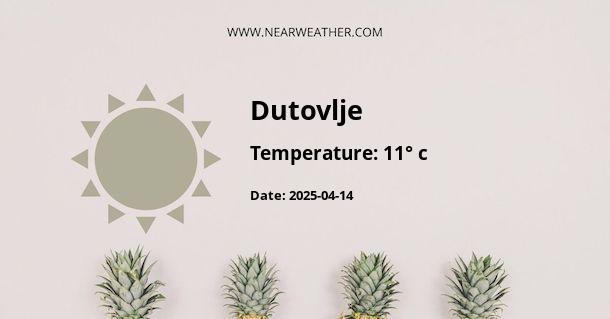Exploring the Climate and Weather of Dutovlje, Slovenia
Dutovlje, a charming village situated in the heart of the Kras region in Slovenia, is a place where the climate and weather are influenced by a mix of Mediterranean and Continental climatic forces. Understanding the intricate details of Dutovlje's climate is key for both residents and visitors, as it governs agriculture, viniculture, and the daily life in this picturesque locale.
General Climate Overview
The general climate of Dutovlje can be characterized as a humid subtropical climate, which is quite typical for the interior of the Slovenian coast. This climate type ensures warm to hot summers and mild to cool winters with a relatively high precipitation spread throughout the year.
Temperature and Precipitation Patterns
Seasonal Temperature Variability
The temperature in Dutovlje varies considerably with the seasons. Summers are typically warm and sometimes hot with average high temperatures reaching up to 30°C (86°F) in July and August, the hottest months of the year. In contrast, during the winter months, particularly in January, the coldest month, temperatures can drop to an average low of around 0°C (32°F).
Annual Precipitation Insights
Dutovlje experiences a significant amount of precipitation. The village receives an average annual rainfall of approximately 1,000 to 1,400 millimeters (39 to 55 inches). Rain is well distributed throughout the year, with late spring and autumn experiencing the highest rainfall due to the influence of the Mediterranean climate.
<table>
<tr>
<th>Month</th>
<th>Average High Temp (°C)</th>
<th>Average Low Temp (°C)</th>
<th>Average Precipitation (mm)</th>
</tr>
<tr>
<td>January</td>
<td>6</td>
<td>0</td>
<td>80</td>
</tr>
<!-- Add remaining months -->
</table>
Wind and Humidity Factors
Winds in the region are predominantly influenced by the Mediterranean Sea and the complex topography of the area. The most significant wind in Dutovlje is the "burja", a strong northeastern wind that can occur during any season but is most common in winter and spring. This powerful wind has a drying effect, which contributes to lower humidity levels and can be a critical factor in viticulture for which the region is well-known.
Humidity Considerations
Relative humidity in Dutovlje fluctuates throughout the year. During the summer, lower humidity levels are recorded, typically ranging from 60% to 70%, while the colder months see higher humidity levels, sometimes exceeding 80%.
Understanding the Unique Microclimate
Dutovlje's microclimate is particularly noteworthy for its impact on the locale's flora and fauna. The combined effect of the nearby Adriatic Sea and the karst landscape creates a unique environmental niche that sustains a variety of plant and animal species.
Implications for Agriculture
Given its climatic conditions, Dutovlje is renowned for its rich viticultural tradition. The combination of sunny days, optimal amounts of precipitation, and the distinctive "Terra Rossa" or red soil of the Karst region contributes to the production of high-quality wines, such as the famous "Teran" wine, a local specialty.
Climate Change Considerations
As climate change continues to impact global weather patterns, Dutovlje is no exception. Recent studies suggest shifts in precipitation patterns and an increase in extreme weather events, potentially affecting local agriculture and the delicate balance of the regional ecosystem.
Conclusion
Dutovlje's climate is representative of the dynamic interplay between Continental and Mediterranean influences, resulting in diverse weather patterns that define the rhythm of life in this Slovenian village. From the winds that sweep through the Kras plateau to the humidity that caresses the vineyards, understanding Dutovlje’s climate is not only of academic interest but a nod to the rich cultural and natural heritage that it supports.
Monthly Weather Averages
For an in-depth understanding, consider the typical monthly weather averages in Dutovlje. The information presented helps residents and tourists alike to prepare for what each season has to offer, ensuring a pleasant experience year-round.
- January: Cold and potentially snowy, with low humidity.
- February: Slightly warmer but still chilly with sporadic precipitation.
- March: Marks the beginning of spring with a mix of rainy and sunny days.
- April: Warmer temperatures and increased rainfall aid the blooming of flora.
- May: Mildly warm with occasional rain showers, ideal for outdoor activities.
- June: The start of summer brings warmer days and longer daylight hours.
- July: Typically the hottest month, with peak temperatures and dry conditions.
- August: Similar to July, with a high chance of heatwaves.
- September: The onset of autumn brings a pleasant dip in temperature.
- October:S: Cooler and wetter as autumn progresses.
- November: Early signs of winter with a significant drop in temperature.
- December: Cold and damp, with potential frost and snow as winter takes hold.
Local Weather Services and Forecasting
Residents and visitors seeking the latest weather forecasts for Dutovlje can turn to a number of resources:
- Slovenian Environment Agency (ARSO) - Provides reliable weather forecasts and climate data.
- Local Radio and TV Stations - Offer daily weather updates.
- Online Weather Services - Websites and apps like AccuWeather and Weather.com provide real-time updates and long-term forecasts.
Understanding Dutovlje's climate is essential for grasping the essence of life in this Slovenian treasure. Whether it's planning an agricultural season, embarking on cultural activities, or exploring outdoor ventures, the weather is an integral part of it all. Embracing its climatic diversity ensures a resilient and harmonious relationship with the natural world of Dutovlje.
A - Dutovlje's Latitude is 45.758060 & Longitude is 13.832220.
A - Weather in Dutovlje is 11° today.
A - Climate Conditions in Dutovlje shows overcast clouds today.
A - Humidity in Dutovlje is 92% today.
A - Wind speed in Dutovlje is 6.91 km/h, flowing at 99° wind direction. today.
